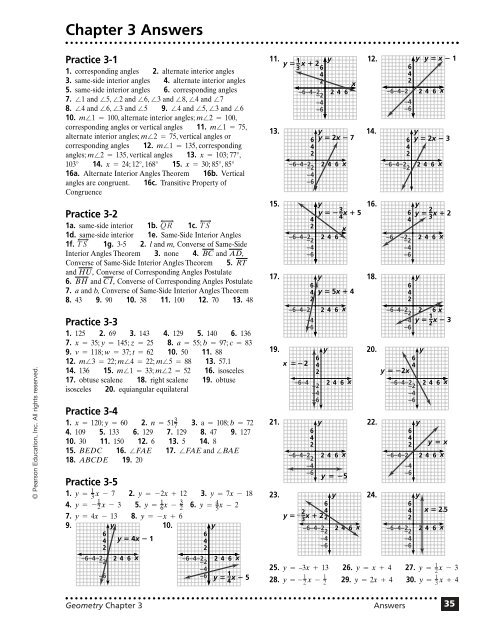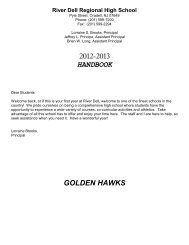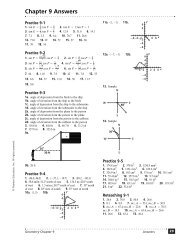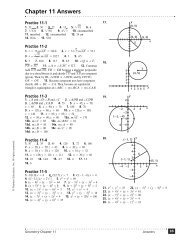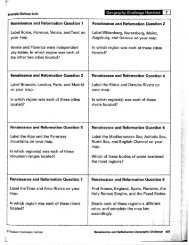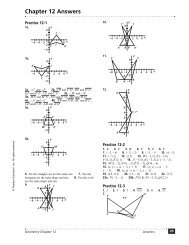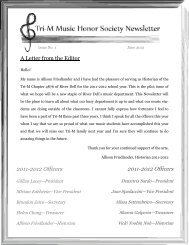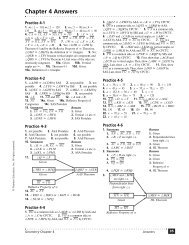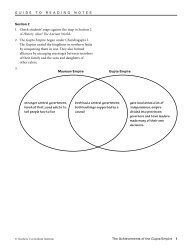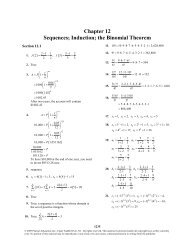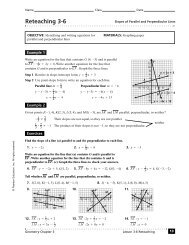chp 3 extra practice answers
chp 3 extra practice answers
chp 3 extra practice answers
You also want an ePaper? Increase the reach of your titles
YUMPU automatically turns print PDFs into web optimized ePapers that Google loves.
© Pearson Education, Inc. All rights reserved.<br />
Chapter 3 Answers<br />
Practice 3-1<br />
1. corresponding angles 2. alternate interior angles<br />
3. same-side interior angles 4. alternate interior angles<br />
5. same-side interior angles 6. corresponding angles<br />
7. 1 and 5, 2 and 6, 3 and 8, 4 and 7<br />
8. 4 and 6, 3 and 5 9. 4 and 5, 3 and 6<br />
10. m1 = 100, alternate interior angles; m2 = 100,<br />
corresponding angles or vertical angles 11. m1 = 75,<br />
alternate interior angles; m2 = 75, vertical angles or<br />
corresponding angles 12. m1 = 135, corresponding<br />
angles; m2 = 135, vertical angles 13. x = 103; 77°,<br />
103° 14. x = 24; 12°, 168° 15. x = 30; 85°, 85°<br />
16a. Alternate Interior Angles Theorem 16b. Vertical<br />
angles are congruent.<br />
Congruence<br />
Practice 3-2<br />
16c. Transitive Property of<br />
* )<br />
1a. same-side interior 1b.<br />
*QR ) 1c. TS<br />
1d.<br />
*<br />
same-side ) interior 1e. Same-Side Interior Angles<br />
1f. TS 1g. 3-5 2. l and m, Converse of Same-Side<br />
Interior Angles Theorem 3. none 4. BC and AD,<br />
Converse of Same-Side Interior Angles Theorem 5. RT<br />
and HU, Converse of Corresponding Angles Postulate<br />
6. BH and CI, Converse of Corresponding Angles Postulate<br />
7. a and b, Converse of Same-Side Interior Angles Theorem<br />
8. 43 9. 90 10. 38 11. 100 12. 70 13. 48<br />
Practice 3-3<br />
1. 125 2. 69 3. 143 4. 129 5. 140 6. 136<br />
7. x = 35; y = 145; z = 25 8. a = 55; b = 97; c = 83<br />
9. v = 118; w = 37; t = 62 10. 50 11. 88<br />
12. m3 = 22; m4 = 22; m5 = 88 13. 57.1<br />
14. 136 15. m1 = 33; m2 = 52 16. isosceles<br />
17. obtuse scalene 18. right scalene 19. obtuse<br />
isosceles 20. equiangular equilateral<br />
Practice 3-4<br />
1. x = 120; y = 60 2. n = 51 3. a = 108; b = 72<br />
4. 109 5. 133 6. 129 7. 129 8. 47 9. 127<br />
10. 30 11. 150 12. 6 13. 5 14. 8<br />
15. BEDC 16. FAE 17. FAE and BAE<br />
18. ABCDE 19. 20<br />
1<br />
1. y = x - 7 2. y =-2x + 12 3. y = 7x - 18<br />
3<br />
7<br />
Practice 3-5<br />
3<br />
1<br />
4. y =- x -<br />
1 3<br />
3 5. y = x - 6. y 4<br />
2<br />
6 2 = 5<br />
x - 2<br />
7. y = 4x - 13 8. y =-x + 6<br />
9. y<br />
10.<br />
y<br />
6<br />
6<br />
4 y 4x 1<br />
4<br />
2<br />
2<br />
–6–4–2<br />
–2<br />
2 4 6 x<br />
–6–4–2<br />
–2<br />
2 4 6 x<br />
–4<br />
–6<br />
–6<br />
1<br />
y <br />
4<br />
x 5<br />
11. 1 y 12.<br />
y x 2<br />
3 6<br />
4<br />
2 x<br />
–6–4–2<br />
–2<br />
2 4 6<br />
–4<br />
–6<br />
13. y<br />
6 y 2x 7<br />
14.<br />
4<br />
2<br />
–6–4–2<br />
–2<br />
2 4 6 x<br />
–4<br />
–6<br />
15. y<br />
16.<br />
3<br />
y x 5<br />
4<br />
4<br />
2 x<br />
–6–4–2<br />
–2<br />
2 4 6<br />
–4<br />
–6<br />
17. y<br />
18.<br />
6<br />
4 y 5x 4<br />
2<br />
–6–4–2 2 4 6 x<br />
–4<br />
–6<br />
19. y<br />
20.<br />
x 2<br />
6<br />
4<br />
2<br />
–6–4<br />
–2<br />
2 4 6 x<br />
–4<br />
–6<br />
21. y<br />
22.<br />
6<br />
4<br />
2<br />
–6–4–2<br />
–2<br />
2 4 6 x<br />
–4<br />
–6<br />
y 5<br />
y y x 1<br />
6<br />
4<br />
2<br />
–6–4–2<br />
–4<br />
–6<br />
2 4 6 x<br />
6<br />
4<br />
2<br />
–6–4–2<br />
–2<br />
–2<br />
–2<br />
–4<br />
–6<br />
y<br />
6<br />
4<br />
2<br />
–6–4–2 2 6<br />
–2<br />
x<br />
1<br />
–4 y <br />
2<br />
x 3<br />
–6<br />
y<br />
6<br />
4<br />
y 2x<br />
2 4 6 x<br />
–6–4–2<br />
–2<br />
–4<br />
–6<br />
2 4<br />
y<br />
6<br />
4<br />
2 y x<br />
–6–4–2<br />
–4<br />
–6<br />
2 4 6 x<br />
23. y 24.<br />
y<br />
6<br />
6<br />
2 4<br />
4 x 2.5<br />
y –<br />
3<br />
x 2 2<br />
2<br />
–6–4–2 2 4 6 x –6–4–2 2 4 6 x<br />
–2<br />
–2<br />
–4<br />
–4<br />
–6<br />
–6<br />
25. y = –3x + 13 26. y = x + 4 27. y =<br />
1<br />
2 x - 3<br />
1 1 1<br />
28. y =- 2 x - 2 29. y = 2x + 4 30. y = 3 x + 4<br />
–6<br />
y<br />
y 2x 3<br />
2 4<br />
6<br />
y<br />
2<br />
6 y <br />
4<br />
3<br />
x 2<br />
6<br />
x<br />
x<br />
Geometry Chapter 3 Answers 35
Chapter 3 Answers (continued)<br />
1 6<br />
31. y =-5<br />
x - 5 32. y =-6x + 45 33. x = 2;<br />
y =-11 34. x = 0; y = 2 35. x =-4; y =-4<br />
36. x =-1; y = 8<br />
37. y<br />
6<br />
38.<br />
4 (4, 0)<br />
2<br />
–6–4–2<br />
–2<br />
–4<br />
–6<br />
–8<br />
–10<br />
–12<br />
2 6 x<br />
(0, 12)<br />
6<br />
(–2, 0)<br />
4<br />
2<br />
–6–4–2<br />
–2<br />
–4<br />
–6<br />
y<br />
2 4 6 x<br />
(0, –1)<br />
4<br />
16. y =-3x + 24<br />
17. y =-x - 3<br />
3<br />
18. y = 5 x + 6<br />
19. y = 0<br />
20. y = 2x - 4<br />
21. y = 2x<br />
Practice 3-7<br />
1.–3.<br />
Q<br />
6<br />
4<br />
2<br />
–6–4<br />
L<br />
–4<br />
y<br />
4<br />
6<br />
x<br />
39. y 40.<br />
6 (0, 6)<br />
4<br />
2<br />
–6–4–2 2 4 6 x<br />
–2<br />
–4 (6, 0)<br />
–6<br />
y<br />
6<br />
1 4<br />
(– 2<br />
2<br />
, 0) (0, 2)<br />
–6–4–2<br />
–4<br />
–6<br />
2 4 6 x<br />
4.–6.<br />
<br />
41. y<br />
42.<br />
6<br />
4<br />
2 (4, 0)<br />
–6–4–2 2 4 6 x<br />
–2<br />
–4 (0, –4)<br />
–6<br />
6<br />
4<br />
2<br />
–6–4–2<br />
–2<br />
–4<br />
–6<br />
y<br />
(0, 1) (8, 0)<br />
2 4 6 8x<br />
7.–9.<br />
T<br />
K<br />
<br />
43. y<br />
44.<br />
y<br />
6 (0, 6)<br />
12 (0, 12)<br />
4<br />
10<br />
(9, 0)<br />
2<br />
x<br />
2<br />
46. y = - 5 x + 8<br />
6<br />
–6–4–2<br />
–2<br />
2 4 6 8<br />
4<br />
–4<br />
(–3, 0) 2<br />
–6<br />
–6 –2 –2<br />
2 4 6x<br />
–4<br />
–6<br />
45a. m = $0.10 45b. the amount of money the worker is<br />
paid for each box loaded onto the truck 45c. b = $3.90<br />
45d. the base amount the worker is paid per hour<br />
Practice 3-6<br />
1 1<br />
1. neither; 3 2 3,3 ? 3 2 -1 2. perpendicular;<br />
1<br />
2 2<br />
2 ? -2 =-1 3. parallel; - 3 = - 3<br />
4. parallel;<br />
-1 =-1 5. perpendicular; y = 2 is a horizontal line,<br />
1 1<br />
x = 0 is a vertical line 6. parallel; - 2 = - 2<br />
1 1<br />
2 2<br />
7. neither; 1 2 8,1 ? 8 2 -1 8. parallel; - 3 = - 3<br />
1 5<br />
9. perpendicular; -1 ? 1 =-1 10. neither; 2 2 - 3 ,<br />
1 5 2 7 2 7<br />
2 ? – 3 2 -1 11. neither; - 3 2 - 12, - 3 ? -12<br />
2 -1<br />
1 1<br />
9<br />
12. neither; 6 2 - 5,6 ? -5<br />
2 -1 13. neither; 2 2 4,<br />
9<br />
1 1 2<br />
2 ? 4 2 -1 14. parallel; 2 = 2<br />
15. y = 3 x<br />
10. Sample:<br />
11. Sample:<br />
b<br />
a<br />
b<br />
c<br />
<br />
© Pearson Education, Inc. All rights reserved.<br />
36<br />
Answers Geometry Chapter 3
Chapter 3 Answers (continued)<br />
12.<br />
1c.–1d. Sample:<br />
b<br />
b<br />
b<br />
120 60<br />
60 120<br />
120 60<br />
60 120<br />
b<br />
2. 110 3. 70 4. 110 5. 110 6. 70 7. 70<br />
8. 110<br />
13.<br />
Reteaching 3-2<br />
1.<br />
l 6 m<br />
Given<br />
1 3<br />
If 6 lines, then<br />
corresponding s are .<br />
a<br />
m3 = m2 = 180<br />
Substitution<br />
2 and 3 are<br />
supplementary.<br />
Definition of<br />
supplementary<br />
c<br />
m1 + m2 = 180<br />
14. Sample:<br />
Angle Addition Postulate<br />
2. 2 3<br />
Given 3 1 a 6 b<br />
b<br />
Substitution If corresponding s,<br />
then lines are parallel.<br />
© Pearson Education, Inc. All rights reserved.<br />
15.<br />
a<br />
Reteaching 3-1<br />
1a.–1b. Sample:<br />
c<br />
a<br />
2 1<br />
Vertical s are .<br />
Reteaching 3-3<br />
1. ABD: mABD = 120, mADB = 30; CBE:<br />
mCBE = 120, mCEB = 30, mBCE = 30; BDE:<br />
mBDE = 60, mDBE = 60, mBED = 60<br />
2. DBE and ABC are acute, equiangular, and<br />
equilateral; ABD and CBE are isosceles and obtuse;<br />
ACE, ADE, CED, and CAD are right and scalene.<br />
3. PQT: mPTQ = 45, mPQT = 90; PQR:<br />
mPQR = 90, mQPR = 45, mQRP = 45; RQS:<br />
mRQS = 90, mQSR = 45; SQT: mSQT = 90,<br />
mQST = 45, mSTQ = 45 4. PT = TS = RS =<br />
PR = 40 mm; PQ = QT = QR = QS = 28 mm<br />
5. PQT, PQR, RQS, SQT, PRS, PTS, PRT,<br />
and RST are right and isosceles.<br />
60<br />
Geometry Chapter 3 Answers 37
Chapter 3 Answers (continued)<br />
Reteaching 3-4<br />
1. 1 and 2 are interior angles; 3 and 4 are exterior<br />
angles. 2. m1 = 135; m2 = 90; m3 = 45;<br />
m4 = 90 3. 1 is an interior angle; 2 and 4 are<br />
exterior angles; 3 is neither. 4. m1 = 60; m2 = 120;<br />
m3 = 60; m4 = 120<br />
Reteaching 3-5<br />
Check students’ graphs.<br />
4. y =<br />
5x + 2 5. y =-x<br />
1<br />
6 2<br />
+ 1 6. y = 1<br />
7 2<br />
7. y =- 2 x + 10 8. y =-x + 1 9. y = 5 x + 1<br />
1. y = 2x - 6<br />
1<br />
2. y = 3 x 3. y =-x - 3<br />
15. y =<br />
1 x +<br />
1<br />
3<br />
4 2<br />
16. y =- 4 x + 4<br />
17. y =-x + 1 18. y = 1<br />
10. y = 1 11. y =-2x - 6 12. x =-3<br />
13. y =-3x + 10 14. y = 3x - 10<br />
1a. -2 1b.<br />
1<br />
2<br />
2a.<br />
1<br />
4<br />
2b. -4 3a. undefined<br />
Reteaching 3-6<br />
3b. 0 4a. y =-2x + 4<br />
1 3<br />
4b. y = 2 x + 2<br />
4c.<br />
y<br />
2<br />
5a. y =-3x - 4<br />
3<br />
5b. y = 2x - 4<br />
5c.<br />
y<br />
4<br />
2<br />
2<br />
4<br />
2<br />
O<br />
2<br />
4<br />
4<br />
2<br />
O<br />
2<br />
4<br />
2<br />
2<br />
4<br />
4<br />
x<br />
x<br />
6a. y = 3x + 7<br />
1<br />
6b. y =-x 3 - 3<br />
6c.<br />
y<br />
4<br />
2<br />
7. m JK =-1; m LM =-1; parallel 8. m JK<br />
= 3; m LM<br />
=<br />
3<br />
1<br />
1<br />
- 2;perpendicular 9. m JK<br />
=-; 6 m LM<br />
=-; 5 neither<br />
3 4<br />
10. m JK<br />
=-; 2 m LM<br />
= 5; neither 11. m JK<br />
= 2; m LM<br />
=<br />
1<br />
1<br />
- 2;perpendicular 12. m JK<br />
= 5 ; m LM<br />
= 5; neither<br />
1 1<br />
13. m JK<br />
= 4 ; m LM =-;parallel 4<br />
14. m JK undefined;<br />
m LM<br />
= 0; perpendicular<br />
Reteaching 3-7<br />
1. Sample:<br />
X<br />
2.–4. Check students’ work.<br />
Z<br />
2<br />
4<br />
2<br />
O<br />
2<br />
4<br />
a<br />
b<br />
Y<br />
Enrichment ) 3-1<br />
1.<br />
*<br />
is # ) * )<br />
)<br />
OE to AB . 2. 3, 5, 1, 4, 2, 6 or 4, 5, 1, 3, 2, 6; OE<br />
is # to AB ; if two angles are congruent and supplementary,<br />
then each measures 90°. 3. 1 > 2; Law of Reflection<br />
4. 2 > 3; Alternate Interior Angles Theorem<br />
5. 3 > 4; Law of Reflection 6. 1 > 4; Transitive<br />
Property of Congruence<br />
Enrichment 3-2<br />
1. x = 11 2. 106 3. 33 4. 41 5. Sample:<br />
Because mBAC = 41, mCAF = 180 - 41 = 139;<br />
2<br />
l 6 m because a pair of alternate interior angles are congruent.<br />
6. CD and EF; AK 7. Sample: CAB and IGH are<br />
corresponding angles related to parallel segments AB and GH.<br />
AK is the related transversal. 8. Sample: A, ADE,<br />
and AED form a triangle, so 180 - (43 + 76) = 61, so<br />
4<br />
x<br />
© Pearson Education, Inc. All rights reserved.<br />
38<br />
Answers Geometry Chapter 3
Chapter 3 Answers (continued)<br />
© Pearson Education, Inc. All rights reserved.<br />
mAED = 61. Because AED and C are congruent<br />
corresponding angles, DE 6 BC by the Converse of the<br />
Corresponding Angles Postulate.<br />
Enrichment 3-3<br />
1. 48 2. 2880 3. 4320 4. Angles have measures of<br />
20, 70, or 90; AC 6MD<br />
6LE<br />
6KF<br />
6 JG; BM6CH<br />
6 NK;<br />
AH 6 PG; CM 6 DL 6 EK 6 JF 6 IG.<br />
Enrichment 3-4<br />
1. 2 2. 5 3. 9 4. 14 5. 20 6. 27<br />
7.<br />
Number<br />
of sides<br />
Total<br />
degree<br />
measure<br />
Number of<br />
diagonals<br />
Enrichment 3-5<br />
1.–8.<br />
RENE DESCARTES<br />
Enrichment 3-6<br />
1. (-3, 4) 2. (-2, 3) 3. (3, 3) 4. (-2, -2)<br />
5. (-1, -1) 6. (4, -1) 7. (1, 0) 8. (2, -3)<br />
9. (-1, 2) 10. (1, -4) 11. (-3, -3) 12. (2, 3)<br />
13. (3, -2) 14. (5, 0) 15. (0, 1) 16. (4, 3)<br />
y-axis<br />
8<br />
4 A<br />
3 N<br />
2<br />
G<br />
1<br />
0<br />
1<br />
E<br />
2 N<br />
3 I<br />
4 L<br />
4 3 2 1<br />
3<br />
K<br />
4 5 6 7 8 9 ... n<br />
180 360 540 720 900 1080 1260 (n 2)180<br />
0 2 5 9 14 20 27<br />
3<br />
5 A<br />
D<br />
L<br />
0<br />
H<br />
R<br />
E<br />
Y<br />
P<br />
R<br />
y<br />
A<br />
1<br />
T<br />
L<br />
B<br />
S<br />
Y<br />
E<br />
N<br />
I<br />
O<br />
P<br />
1 2 3 4<br />
M<br />
T<br />
4<br />
n(n 3)<br />
2<br />
6<br />
C<br />
N<br />
5 x-axis<br />
7<br />
2<br />
x<br />
Enrichment 3-7<br />
1., 3., and 4.<br />
A<br />
2. scalene, acute triangle 5. No; refer to the answer to<br />
Exercises 1, 3, and 4.<br />
6.<br />
E<br />
7. isosceles, obtuse triangle<br />
Chapter Project<br />
Activity 1: Paper Folding<br />
5; all triangles are right isosceles; yes.<br />
Activity 2: Exploring<br />
triangle<br />
quadrilaterals<br />
B<br />
D<br />
F<br />
C<br />
Geometry Chapter 3 Answers 39
Chapter 3 Answers (continued)<br />
pentagons<br />
hexagons<br />
✔ Checkpoint Quiz 2<br />
1. pentagon; 80 2. hexagon; x = 110; y = 98<br />
3. quadrilateral; x = 94; y = 105<br />
4. y<br />
5.<br />
6.<br />
8<br />
6<br />
4<br />
2<br />
42<br />
2<br />
4<br />
6<br />
8<br />
y<br />
8<br />
6<br />
4<br />
2<br />
864 2 4 6 8<br />
2<br />
4<br />
6<br />
8 (0,8)<br />
(12,0)<br />
2 4 6 8 1012 x<br />
(0,8)<br />
2<br />
(2,0)<br />
x<br />
y<br />
8<br />
6<br />
4 (0,3)<br />
(1.2,0) 2<br />
864 2 2 4 6 8<br />
2<br />
4<br />
6<br />
8<br />
x<br />
Activity 3: Analyzing<br />
Activity 4: Modeling<br />
✔ Checkpoint Quiz 1<br />
1. Converse of Corresponding Angles Postulate<br />
2. Alternate Interior Angle Theorem 3. Same-Side<br />
Interior Angles Theorem 4. Corresponding Angles<br />
Postulate 5. Converse of Alternate Interior Angle<br />
Theorem 6. Vertical Angles Theorem 7. Converse<br />
of Corresponding Angles Postulate 8. Corresponding<br />
Angles Postulate 9. Converse of Same-Side Interior<br />
Angles Theorem 10. x = 50, y = 30, z = 65<br />
7. Parallel; slopes are the same. 8. neither<br />
9. Perpendicular; the product of the slopes is -1.<br />
10. neither<br />
Chapter Test, Form A<br />
1. true 2. true 3. false 4. false 5. true<br />
6. false 7. true 8. true 9. Answers may vary.<br />
Sample: m1 = 125, Same-Side Interior Angles Theorem; m2<br />
= 55, Alternate Interior Angles Theorem 10. Answers may<br />
vary. Sample: m1 = 60, Corresponding Angles Postulate then<br />
Angle Addition Postulate; m2 = 60, Same-Side Interior<br />
Angles Theorem 11. Answers may vary. Sample: m1 = 85,<br />
Alternate Interior Angles Theorem; m2 = 95, Same-Side<br />
Interior Angles Theorem 12. Answers may vary. Sample:<br />
m1 = 75, Corresponding Angles Postulate; m2 = 105,<br />
Angle Addition Postulate 13. Answers may vary. Sample:<br />
m1 = 91, Corresponding Angles Postulate and Same-Side<br />
Interior Angles Theorem; m2 = 89, Corresponding Angles<br />
Postulate 14. Answers may vary. Sample: m1 = 60,<br />
Alternate Interior Angles Theorem; m2 = 115, Same-Side<br />
Interior Angles Theorem<br />
15.<br />
16.<br />
x<br />
X<br />
y<br />
m<br />
© Pearson Education, Inc. All rights reserved.<br />
40<br />
Answers Geometry Chapter 3
Chapter 3 Answers (continued)<br />
17. WA and XB 18. none 19. WZ and AB<br />
20. none 21. WZ and AB 22. WZ and AB;<br />
AX<br />
and BY 23. x = 22; y = 120 24. x = 70; y = 60;<br />
z = 120 25. x = 35; y = 35; z = 55 26. 5940<br />
27. 18 28. perpendicular 29. neither 30. parallel<br />
31. y = 6x + 23<br />
1<br />
32. y =-x 2 + 3<br />
1<br />
33. y = 3x + 2<br />
Chapter Test, Form B<br />
1. false 2. false 3. false 4. true 5. false<br />
6. false 7. false 8. true 9. Answers may vary.<br />
Sample: m1 = 120, Corresponding Angles Postulate;<br />
m2 = 120, Alternate Interior Angles Theorem<br />
10. Answers may vary. Sample: m1 = 90, Same-Side<br />
Interior Angles Theorem; m2 = 90, Vertical Angles Theorem<br />
11. Answers may vary. Sample: m1 = 75, Alternate Interior<br />
Angles Theorem; m2 = 80, Same-Side Interior Angles<br />
Theorem 12. Answers may vary. Sample: m1 = 80,<br />
Corresponding Angles Postulate; m2 = 100, Same-Side<br />
Interior Angles Theorem 13. Answers may vary. Sample:<br />
m1 = 88, Corresponding Angles Postulate; m2 = 92,<br />
Same-Side Interior Angles Theorem 14. Answers may<br />
vary. Sample: m1 = 150, Corresponding Angles Postulate<br />
and Angle Addition Postulate; m2 = 91, Corresponding<br />
Angle Postulate and Vertical Angles Theorem<br />
15.<br />
Y<br />
n<br />
Alternative Assessment, Form C<br />
TASK 1: Scoring Guide<br />
a.<br />
t<br />
1 2<br />
4 3<br />
a<br />
5 8<br />
6 7<br />
b<br />
b. Sample: 8 2; 8 4; 8 and 3 are<br />
supplementary. c. m2 = 75; m3 = 105, m4 = 75,<br />
m5 = 105, m6 = 75, m7 = 105, m8 = 75<br />
d. 7 and 4 are supp.<br />
Given<br />
7 and 8 are supp.<br />
Angle Add. Post.<br />
4 8<br />
Supp. of the<br />
same are .<br />
a 6 b<br />
If alt. int s<br />
are , then<br />
lines are 6.<br />
3 Student draws an accurate diagram and supplies correct<br />
<strong>answers</strong> and a complete and accurate flow proof.<br />
2 Student draws a figure or gives <strong>answers</strong> that contain<br />
minor errors.<br />
1 Student draws a figure or gives <strong>answers</strong> that contain<br />
significant errors or omissions.<br />
0 Student makes little or no attempt.<br />
© Pearson Education, Inc. All rights reserved.<br />
16.<br />
x<br />
y<br />
17. AB and ED 18. AE and BD 19. EB and DC<br />
20. none 21. none 22. AE and BD; EB and DC<br />
23. x = 70; y = 70; z = 110 24. x = 33; y = 33;<br />
z = 114 25. x = 90; y = 25; z = 50 26. 4500<br />
27. 15 28. parallel 29. neither 30. perpendicular<br />
1<br />
2<br />
31. y = 4x + 17 32. y =-x 3 - 4 33. y =-x 3<br />
TASK 2: Scoring Guide<br />
Sample:<br />
A<br />
Q<br />
P<br />
B<br />
3 Student constructs an accurate figure.<br />
2 Student constructs a figure that contains minor errors<br />
or omissions.<br />
1 Student constructs a figure that contains significant errors<br />
or omissions.<br />
0 Student makes little or no attempt.<br />
Geometry Chapter 3 Answers 41
Chapter 3 Answers (continued)<br />
TASK 3: Scoring Guide<br />
Sample:<br />
TASK 4: Scoring Guide<br />
Sample:<br />
A<br />
C<br />
B<br />
D<br />
Isosceles<br />
Triangles<br />
Equilateral<br />
Triangles<br />
Triangles<br />
R<br />
a. For the figure given, y = x and y = x + 3. The lines are<br />
parallel because both lines have a slope of 1.<br />
c. For ABC, the sum of the three angles is 180°. Minor<br />
discrepancies are the result of measurement error and<br />
rounding error.<br />
d. For the figure given, ABDC is not regular. By the<br />
distance formula, the sides are not congruent.<br />
3 Student draws the figure accurately, writes correct equations,<br />
and reasons logically.<br />
2 Student draws a figure, gives arguments, and writes<br />
equations that are mainly correct but may contain minor<br />
errors.<br />
1 Student presents work with significant errors.<br />
0 Student makes little or no attempt.<br />
3 Student draws an accurate diagram.<br />
2 Student draws a diagram that contains minor errors<br />
or omissions.<br />
1 Student draws a diagram that contains significant errors<br />
or omissions.<br />
0 Student makes little or no attempt.<br />
Cumulative Review<br />
1. D 2. B 3. C 4. A 5. D 6. D<br />
7. A 8. A 9. C 10. D 11. D 12. D<br />
13. B 14. B 15. C 16. B 17. C<br />
18. Given 19. Same-Side Interior Angles Theorem<br />
20. Corresponding Angles Postulate 21. Corresponding<br />
Angles Postulate 22. substitution 23. Check students’<br />
work. 24. Sketches may vary. The right angle must be<br />
between the equal sides. 25. No; a triangle cannot have<br />
two sides equal and no sides equal at the same time.<br />
© Pearson Education, Inc. All rights reserved.<br />
42<br />
Answers Geometry Chapter 3


